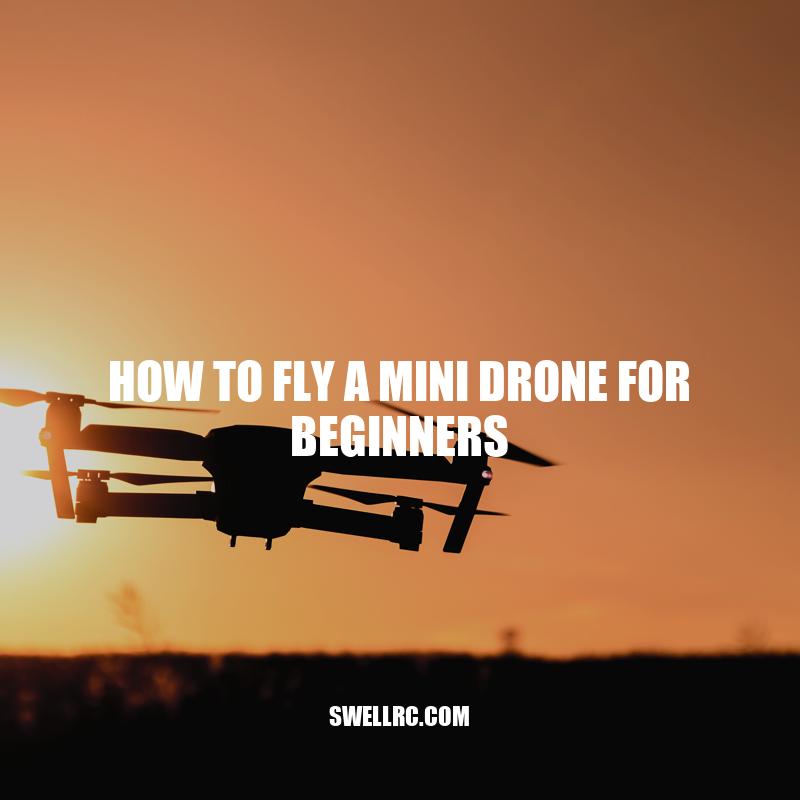Mini Drone Flying: Beginner’s Guide
Drones have become extremely popular over the last few years, and it’s not hard to see why. They offer a unique perspective and allow users to capture stunning aerial footage that would otherwise be impossible. If you’re new to the world of drones, you might be wondering how to get started. Flying a mini drone is a great way to begin; they’re smaller and more affordable than their larger counterparts, making them perfect for beginners. However, it can be tricky to know where to start when it comes to learning how to fly a mini drone. In this article, we’ll take you through everything you need to know to get started, from choosing the right mini drone to mastering basic controls and safety tips to keep in mind. By the end of this article, you’ll have the knowledge you need to feel confident taking to the skies with your mini drone.
Choosing the Right Mini Drone
When it comes to buying a mini drone, there are a few factors you should consider before making your purchase. Here are some things to keep in mind:
- Budget: Determine how much you’re willing to spend on a mini drone. Prices can range anywhere from $20 to $200 or more, so it’s important to know what you can afford.
- Size: Mini drones come in a variety of sizes, so you’ll want to think about how and where you’ll be using your drone before making your choice.
- Skill Level: Some mini drones are better suited for beginners than others. Look for models that are easy to handle and come with helpful features like altitude hold.
There are many options on the market, so it’s important to do your research to find the perfect mini drone for you. Some of the most highly recommended brands for beginners include:
- DJI
- Holy Stone
- Snaptain
- Potensic
Many websites offer comprehensive reviews and comparisons of different mini drones, such as Drone Rush and MyFirstDrone, so be sure to check these out for additional guidance.
What is the best mini drone to buy?
Here are some top mini drones that you can consider buying:
- DJI Mavic Air 2
- Hubsan H107D+
- Ryze Tech Tello
- Parrot Mambo
- Snaptain SP510
These drones are great for beginners, easy to fly and comes with great features. You can purchase these drones on websites like Amazon, BestBuy, or directly from the manufacturer’s website.
Unpacking and Assembling
Once you’ve selected the mini drone that’s right for you, it’s time to unpack and assemble it. Follow these steps to ensure proper assembly:
- Remove all items from the box and lay them out on a flat surface.
- Refer to the instruction manual for specific assembly instructions.
- Connect the battery to the drone and make sure it’s fully charged.
- Attach the propellers to the drone using the provided tools.
- Install the controller batteries and turn it on.
- Sync the controller to the drone by following the instructions.
It’s important to make sure all parts are connected properly before taking off. When assembling, take note of the following:
- Double-check the propellers to make sure they are secure and correctly oriented.
- Make sure the battery is inserted properly and clicked into place.
- Be careful not to overtighten screws, as this could damage the parts.
One interesting fact about mini drones is that they come with various features that allow for different flight modes, such as auto-pilot, altitude hold, and more. It’s important to read the instruction manual to familiarize yourself with these features.
| Pros | Cons |
|---|---|
| Easy to travel with and carry | Short battery life |
| Low cost compared to bigger drones | Susceptible to wind gusts and turbulence |
| Fun and easy to fly indoors | Not as powerful or fast as other drones |
There are many resources available online for those learning to assemble and fly mini drones. Be sure to check the manufacturer’s website and online tutorials for additional guidance.
How do you control a drone with a controller?
Controlling a drone with a controller is easy, and can be done by following these simple steps:
- Ensure the drone’s batteries are charged, and that the controller has fresh batteries or is fully charged.
- Turn on the controller and the drone.
- Pair the drone and controller using the instructions provided by the manufacturer. This usually involves pressing a button on the drone and on the controller.
- Once paired, you can manipulate the drone’s movement by using the controller’s joysticks. The left joystick controls altitude and rotation, while the right joystick controls forward/backward and left/right movement.
- Some controllers may also have additional buttons for adjusting camera angles, taking photos, or activating “return to home” mode.
For more detailed instructions, check out the user manual for your specific drone model. You can also find helpful tutorials and troubleshooting tips on websites such as DJI.com or on Amazon’s drone product pages.
Basic Controls
Before taking off on your mini drone, it’s important to understand the basic controls. These include the throttle, pitch, yaw, and roll. Here’s what each one does:
- Throttle: This controls the altitude of the drone – pushing the throttle up will make it ascend and pulling it down will make it descend.
- Pitch: This tilts the drone forward or backward, allowing it to move in that direction.
- Yaw: This rotates the drone left or right, changing the direction it is facing.
- Roll: This tilts the drone left or right, allowing it to move in that direction.
Remember, practicing in an open area is key to getting comfortable with the basic controls. Start with slow movements and adjust the speed as you gain confidence.
Online tutorials and simulators can help beginners learn the basic controls without risking the damage to the drone. Websites like DJI, Parrot, and Udemy offer courses and tutorials in drone flying for beginners.
Additionally, apps like AirMap and DroneDeploy provide interactive maps, flight planning tools, and cloud-based data management for hobbyists as well as professional drone pilots. By integrating with drones and software, these apps can help pilots fly their mini drones with advanced techniques and skills.
How do I start a control system?
Starting a control system can seem like a daunting task, but with the right approach, it can be a manageable and rewarding experience. Here are a few steps you can take to get started:
- Identify your needs and goals: Determine what you want your control system to achieve and what features you require.
- Choose a platform: Look for a software or hardware platform that meets your needs, such as Arduino, Raspberry Pi or other similar platforms.
- Consider compatibility: Make sure your platform is compatible with the sensors, actuators, and other components you need for your control system.
- Start small: Begin with a simple project, and gradually add complexity and functionality to your system as you learn more.
- Research online: Look for resources online, such as tutorials, forums, and product reviews to help you understand the different aspects of control systems and to get ideas for your project.
There are many websites and products that can help you get started with control systems, including Adafruit, Sparkfun, and Amazon, among others.
Flight Modes
Mini drones come with a variety of flight modes to cater to different levels of users. Here are some of the most common modes you’ll find on a mini drone:
- Auto mode: This is the easiest mode for beginners, and it controls the drone’s altitude and speed automatically.
- Manual mode: This is the advanced mode for experienced users who want to have more control over their drone.
- Altitude hold mode: This mode keeps the drone at a fixed altitude so that the pilot can focus on the movement without worrying about the altitude changes.
It’s important to familiarize yourself with the different flight modes and how they work. Some mini drones will have additional features such as headless mode (the drone automatically faces the controller’s direction), and one-key return (the drone automatically returns to the starting point).
Most mini drones in the market today come with intuitive mobile apps that allow users to control their drones with ease. Apps like DJI Fly, Parrot FreeFiight, and Syma Go offer flight modes and other automated features that can make flying a mini drone easier for beginners. Also, websites such as Amazon, BestBuy, and Walmart provide a wide range of mini drones with advanced flight modes that can cater to different users’ needs.
What are the three main types of drones?
Drones come in various shapes and sizes, but they can be classified into three main categories based on their design and capabilities. These categories include:
- Multi-rotor Drones: These drones have multiple rotors (usually 4-8) that allow them to take off and land vertically, hover in place, and perform complex maneuvers. They are the most common type of consumer-grade drone and are popular for aerial photography and videography. Examples of multi-rotor drones include the DJI Mavic and the Parrot Bebop.
- Fixed-wing Drones: These drones look like miniature airplanes and have a single wing and a propulsion system. They are designed to fly long distances and cover large areas quickly, making them ideal for mapping, surveillance, and agricultural applications. Examples of fixed-wing drones include the SenseFly eBee and the DJI Phantom 4 RTK.
- Single-rotor Helicopters: These drones are also known as “helicopter drones” and have a single rotor that allows for vertical takeoff and landing. They are often used for military and industrial applications, such as search and rescue missions and inspecting power lines. Examples of single-rotor helicopters include the AeroVironment Snipe and the Pulse Aerospace Vapor 15.
If you are interested in purchasing a drone, it’s important to understand these basic types and their capabilities to determine which one is right for your needs.
Safety Tips
Flying a mini drone can be exciting, but it’s crucial to follow safety precautions to avoid any accidents or injuries. Here are some essential safety tips to keep in mind:
- Fly in open areas: Find a spacious and open area to practice your drone flying skills. Avoid flying in crowded spaces, near high-traffic roads, or close to buildings.
- Learn the rules: Before flying, understand the regulations and guidelines in your area.
- Keep your drone in sight: Never lose sight of your drone while flying. Keep it within your line of sight to avoid collisions or losing your drone.
- Beware of weather conditions: Avoid flying in extreme wind, rain or snow conditions that can interfere with your drone’s performance.
- Practice: Practice makes perfect, and the more you practice flying your drone, the better you become. Start slow and steady, then build up your skills gradually.
To ensure your drone’s safety, always keep it away from young children and animals. Also, websites like DJI, FAA and BestBuy have a comprehensive guide on the essential safety precautions and regulations to follow while using mini drones. By following these tips, you can stay safe and enjoy your mini drone’s best experience!
What are the 7 basic safety rules?
Here are the 7 basic safety rules that everyone should know and follow:
- Wear appropriate safety gear and personal protective equipment (PPE)
- Be alert and aware of your surroundings
- Follow all warning signs and safety instructions
- Never run or horseplay
- Use tools and machinery properly
- Report all accidents, injuries, and near misses immediately
- Practice good housekeeping to prevent slips, trips, and falls
Following these rules ensures a safer workplace and reduces the risk of accidents and injuries. For more information on workplace safety, visit the Occupational Safety and Health Administration (OSHA) website.
Conclusion
Learning how to fly a mini drone can be a thrilling experience, but it requires patience and practice. Remember to choose the right mini drone for your skill level, unpack and assemble it correctly, and understand the basic controls and flight modes. In addition, following the essential safety precautions is crucial to avoid any mishaps while flying the mini drone.
There are tons of resources available online, including websites, forums, and instructional videos, that can offer additional guidance and tips to help you succeed in drone flying. DJI, Amazon, and Best Buy have a wide selection of mini drones and accessories to choose from, making it easier to find the perfect drone for your skill level.
Get your drone, practice your flying skills, and explore the endless possibilities of drone technology. The more you practice, the better you become at flying, and soon, you might be able to impress your friends with some cool aerial stunts!



